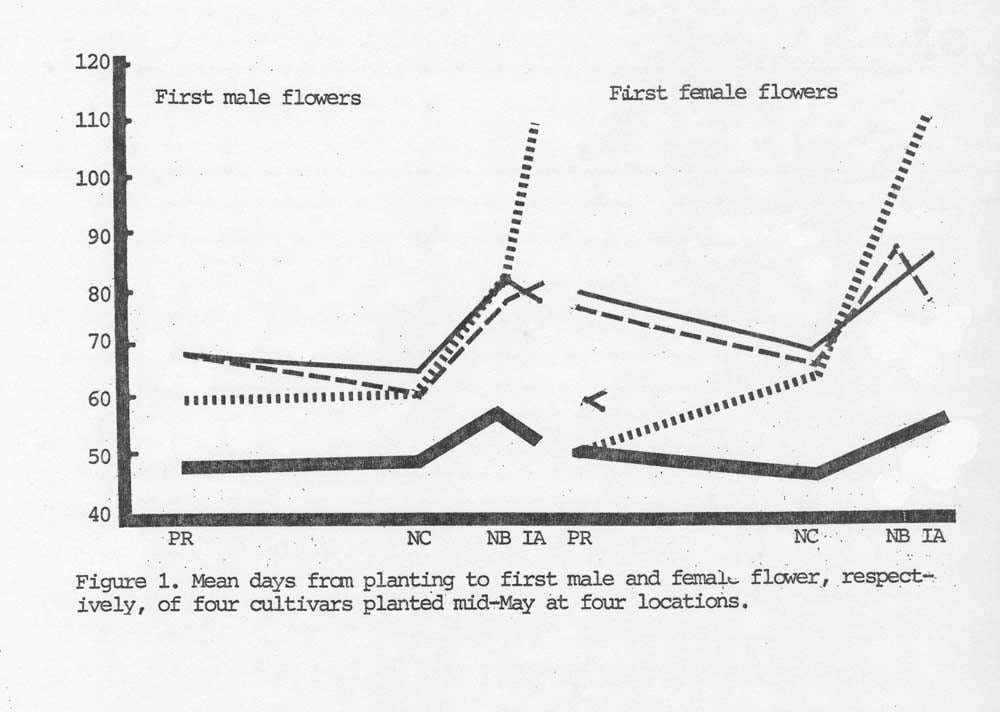Cucurbit Genetics Cooperative Report 9:102-103 (article 33) 1986
D.W. Unander and F. Varela Ramfrez
Depo. de Horticultura, Estacion Experimental Agricola, Apartado 506, Isabela, PR 00662
Cucurbita moschata Duch.ex Poir. is grown in temperate and tropical zones. ‘Ponca’ butternut, a vigorous selection in Nebraska (1), was observed to have a dwarfed unthrifty growth and small fruits in Puerto Rico. Tropical calabaza, however, performs very well in New Jersey, and is a commercial crop there (personal observation). As a first step in understanding these differences, we looked at the effect of latitude on flowering of diverse cultivars.
Methods. Ponca and three other cultivars were planted in mid-May at eight latitudes. ‘La Primera’ was bred in Florida, ‘Borinquen’ in Puerto Rico and Colombia 34′ in Colombia. Locations included Isabela, Puerto Rico, (about 18˚N),Clinton, North Carolina (35˚), Lincoln, Nebraska (41˚) and Decorah, Iowa 43.5˚). Data not yet received from other locations will not be discussed. Dates of first male and first female flowers were recorded. Experimental design varied among locations, and will not be described here, but all plantings were replicated.
Results. Figure 1 illustrates flowering data. Ponca showed little difference in flowering response. Any daylength effect within these latitudes on Borinquen and Colombia 34 is not marked. A cooperator in Darwen, England (53.5˚N) planted Borinquen in mid-May and grew it past frost in a greenhouse, but no flowering was ever observed. The response of La Primera suggests that some genotypes have photoperiod-sensitive flowering responses. Nitsch et al (3) reported long days slowed flower development in acorn squash (C. pepo L.), and that temperature and daylength interacted with each other. The response of La Primera would be consistent with this. Perhaps an interaction of temperature and daylength accounts for the decrease in days to flower of some cultivars at North Carolina.
Ponca showed little change in days to flower, but it again produced small plants and fruits in the south Ponca in Puerto Rico produces fruits consistently half or less the average weight in Nebraska of 0.8 – 1.3 kg (1). Hall (2) examined photoperiod response of gherkin (Cucumis anguria L.), “Essentially day-neutral in flowering response”, and found that 16 hour days produced larger plants and better growth responses in various characters than eight hour days. Perhaps Ponca responds in a similar manner (Table 1). These data are intriguing, albeit limited, and we hope that complete data and further studies will shed more light.
The cooperation of Dermot Coyne (Nebraska), Glenn Drowns (Iowa), C.H. Miller (North Carolina) andJohn Syncoill (England) is gratefully acknowledged.

Figure 1. Mean days from planting to first male and female flower, respectively, of four cultivars planted mid-May at four locations
Table 1. Mean fruit weight (kg) of four cultivars at four locations.
| PR | NC | NB | IA | |
| Ponca | 0.4 | 0.5 | 0.7 | 1.5 |
| La Primera | 5.0 | -y | 4.3 | – |
| Borinquen | 2.9 | – | 2.8 | – |
| Colombia 34 | 4.2 | 4.4 | 6.4 | – |
| y = denotes no fruit produced at this location. | ||||
Literature Cited
- Coyne, D.P. 1976. ‘Butternut Ponca’ squash. HortScience 11:617.
- Hall, W.C. 1949. Effects of photoperiod and nitrogen supply on growth and reproduction in the gherkin. Plant Physiol. 24:753-769.
- Nitsch, J.P., E.B. Kurtz, J.L. Liverman and F.W. Went. 1952. The development of sex expression in cucurbit flowers. Amer. J. Bot. 39:32-43.